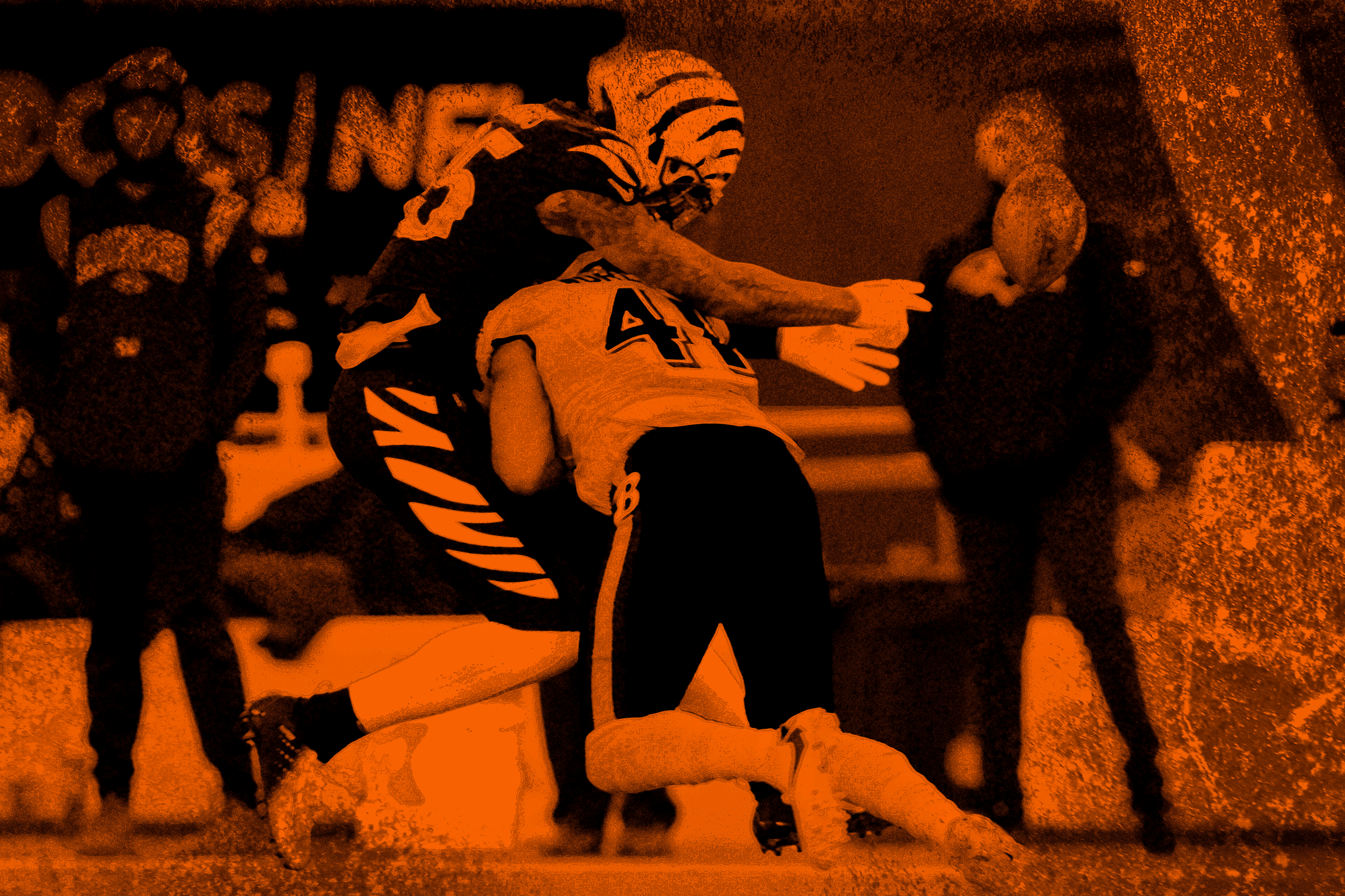
Fox’s telecast-opening action figure Cleatus the Robot and the other mega-vision scoreboard graphics that litter screens are audience-inuring. What’s more, they render it difficult for NFL players to get real economic justice for their work. The padded figures on the field have been so commodified and exaggerated all out of shape that it desensitizes the viewer to what they experience on even the most ordinary, innocuous play. Which is what Hamlin’s tackle of Cincinnati Bengals wide receiver Tee Higgins was: a rank-and-file occurrence. The heart attack that sent him into critical condition was a one-in-a-million fluke, cause still unknown, and his recovery is a miracle to be grateful for on our knees. But the play was basic.
It’s time for a refresher course in basic Newtonian physics. When you properly understand the kinematics NFL players experience, you can’t ever again think they’re overpaid.
You want to feel what NFL players do on an average play? Run full speed into a wall mirror.
And while you’re lying on your back trying to regain your senses, consider the following math problem: Two large NFL players, who cover 40 yards in less than 4.5 seconds, collide, causing each to decelerate to zero. Roughly how much force do they — their skin, their bones and their organs — endure on just a single such play?
To do the calculations, I reached out to Tim Gay, a renowned physicist at the University of Nebraska who wrote an indispensable book, “The Physics of Football,” in which he describes these “mirror collisions” with a clarity and plain-spokenness that makes the math accessible. Gay went to prep school with Bill Belichick at Phillips Academy Andover, where he managed the football team, and he went on to play on the offensive line while getting his degree in physics at Cal Tech. When he’s not studying polarized electron scatterings and “chiral and dichroic effects,” he likes to pencil out the Newtonian principles of football and spent years puzzling over the beautiful parabolic flight of a long spiral pass, publishing a paper on it in 2021.
As Gay explains, when two players of roughly similar size and speed collide, their weights and momentum don’t really tell the full story. What matters as much is the catastrophically short duration of time in which they go from high acceleration to zero. It’s as much about the stopping as the running.
Gay keeps the numbers basic for the sake of clarity. Let’s say a running back or receiver weighs around 220 pounds, and so does a defender. It’s a sound middling number. The Bengals’ Higgins weighs in at about 220 pounds, while a running back such as Saquon Barkley of the New York Giants is about 230. Among defenders, Hamlin is 200 pounds, while a linebacker such as Lavonte David of Tampa Bay checks in at about 230. All of them run somewhere in the range of 20 to 21 mph.
You get the drift. Two men of about 220 pounds (or 100 kilograms) run on a field until they reach top speeds of about 10 meters per second — when the defender suddenly slams into the receiver and brings him to a dead halt. Now their speeds are zero. Newton’s Second Law: force equals mass times acceleration. The acceleration — or deceleration in this case — is determined by the change in speed of the player divided by the time over which it occurs. The duration of hits can vary dramatically, of course, but Gay has studied NFL films enough to assert that a fair estimate to use is one to two tenths of a second.
Do the math. Multiply the mass by the acceleration, and divide by the time interval over which the change in speed occurs. The backward deceleration comes out to minus 240 feet per second squared.
That’s 1,650 pounds — or about three-fourths of a ton. “You get forces equal to the weight of a baby whale,” Gay says.
If the mirror trick doesn’t illustrate an NFL tackle vividly enough, then go to Sea World and let a young orca slam into you face first. Now you’re feeling it.
Gay has toyed with other calculations. When two players collide helmet to helmet — only sometimes against the rules — he estimates it’s akin to having a 16-pound bowling ball dropped on the head from a height of 12 feet.
Even the noncontact forces on the field are breathtaking when Gay puts them in kinetic-mathematical context. Gay once calculated the force with which a great NFL runner-receiver makes a lateral cut. It’s one of the most transfixingly elegant moves on the field — “They almost teleport,” Gay says admiringly — and he wanted to measure it. There are two forces being exerted when a player hard-plants his foot — that of the body, and that of the turf. “The ground obeys Newton’s Third Law and pushes back on him with the same force,” Gay says. “About 800 pounds of force shoot through his ankle and his foot.”
And then there is the torque of a face mask penalty in the NFL, which he frames with an especially vivid comparison. “It’s about the same as if you stuck your neck in an industrial washing machine at full speed,” he says.
As you watch the playoffs, remember the most important physical statistic of all. This one any innumerate person can understand: The injury rate in the NFL is 100 percent. They all get hurt. Fully one in four of the league’s retirees will need a joint replacement. They suffer arthritis at five times the rate of their peers. And they are four times as likely to suffer neurodegenerative diseases, such as Alzheimer’s or ALS. Yet, the NFL’s health insurance program lasts five years after retirement — if they qualify for it.
Enough with the souped-up graphics and caricatures, which portray NFLers as if they are metallic-skinned, armored, shapeshifting Transformers, iron-hides with replaceable parts. They are vulnerable bodies in extreme motion. And that should be drama enough for the viewer.







